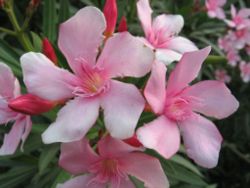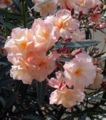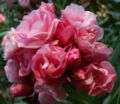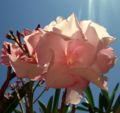Nerium oleander
| Nerium oleander subsp. var. | ||||||||||||||||||||||||||||||||||||||||||||||||||||||||
|---|---|---|---|---|---|---|---|---|---|---|---|---|---|---|---|---|---|---|---|---|---|---|---|---|---|---|---|---|---|---|---|---|---|---|---|---|---|---|---|---|---|---|---|---|---|---|---|---|---|---|---|---|---|---|---|---|

|
|
| ||||||||||||||||||||||||||||||||||||||||||||||||||||||
| ||||||||||||||||||||||||||||||||||||||||||||||||||||||||
| Standard Cyclopedia of Horticulture |
|---|
|
Nerium odorum, Soland. Sweet-scented Oleander. Stout erect shrub: Lvs. in 3's, linear-lanceolate: fls. rosy pink, 2 in. across, in clusters of as many as 80, fragrant; appendages of the anthers protruding; segms. of the crown 4-7, long and narrow. Persia, India, Japan. B.R. 74 (fls. double). B.M. 1799 and 2032. G.C. III. 50: suppl. July 8, 1911.—A less robust plant with Lvs. commonly narrower and more distant, and angled branches. In wild plants the calyx-lobes of N. Oleander are spreading; of N. odorum erect. It has the same range of color as the above, and single and double forms. Prop, by layers or cuttings.
|
| Standard Cyclopedia of Horticulture |
|---|
|
Nerium oleander, Linn. (N. lauriforme, Lam.). Oleander. Rose Bay. (Another plant called "Rose Bay" is Epilobium angustifolium.) Fig. 2476. Lvs. in 2's or 3's, lanceolate: appendages of the anthers scarcely protruding; segms. of the crown 3—4-toothed. Medit. region, Orient. Gn. 51, p. 81 (fine trees in vases). A.F. 10:265 (Bermuda shrub with a spread of 25 ft.). L.B.C. 7:666 (var. Loddigesii, with a variegated fl. and the appendages entire, ovate and obtuse). N. album, N. atropurpureum, N. carneum and N. roseum, Hort., are doubtless varieties. The plant is common in subtropical and tropical countries, sometimes planted in hedges, and sometimes runs wild.
|
Nerium oleander {{{latin_name}}}
|
Oleander
| ||||||||||||||||||||||||||||||||||||||||
|---|---|---|---|---|---|---|---|---|---|---|---|---|---|---|---|---|---|---|---|---|---|---|---|---|---|---|---|---|---|---|---|---|---|---|---|---|---|---|---|---|---|

|
|
| |||||||||||||||||||||||||||||||||||||||
| |||||||||||||||||||||||||||||||||||||||||
Oleander thrives best in warm summer climates where winters are mild. Growth is moderate/fast. Natural habit is broad with many stems, but training it to tree form is easy. It is very useful as windbreak, privacy screen, along roads, in tubs. The leaves are dark green and leathery, narrow, 5-21 cm long and 1-3.5 cm broad, and with an entire margin. Plant and leaves are attractive year round. There is a variegated form with golden margins on the leaves.
Flowers at the end of branches come in clusters, each flower is 2.5-5 cm diameter. The long bloom period from spring to fall is one of the reasons for its popularity, with the extreme drought tolerance being another. Many cultivars have scented flowers, coming in red, pink, white salmon and yellow. Double flowers are less common than single. Single flowers fall off after finishing, while double flowers turn brown and remain until trimmed off.
Oleander is an extremely poisonous plant if ingested. In case it is ingested, vomiting should be induced, and immediate treatment sought. Do not use trimmed branches for barbecues or fires.
Cultivation
| Oleander calendar? | ||
|---|---|---|
| January: | ||
| February: | ||
| March: | prune | |
| April: | flowering | |
| May: | flowering | |
| June: | flowering | |
| July: | flowering | |
| August: | flowering | |
| September: | flowering | |
| October: | flowering | |
| November: | ||
| December: | ||
| Notes: | ||
It needs regular water until established, then extremely drought tolerant, though regular water is fine with them any time. It is very tolerant of bad or salty soil. Shade causes leggy growth and stunts blooming, as does fog.
Prune to control size and shape in the early spring. Old wood should be removed, branches may be cut to ground. Unwanted suckers should be hand pulled, not cut, for best control. Pinching or pruning of grow tips can help keep height down. Cut branches exude a milky sap (poisonous as well!).
Potted plants do not like frequent repotting.
Propagation
For exact clones of the parent variety, cuttings are required. In spring or summer, take a 15 cm cutting without flowers and place in water. When roots reach 3 cm, it can be potted up. After it is established it can be planted in the garden. It will grow very quickly under the right conditions, and may flower the same year. Seeds can be planted as well, for new varieties.
Pests and diseases
- Oleander caterpillars can eat much of the plants leaves.
- Greenflies may appear in warm/dry spring weather, attacking tender buds. They are yellow or ochre and suck the sap from tender buds, weaken them, and make them sticky. Mineral oil with insecticide is effective.
- Cochineals - like scabs that stick to leaves/buds. These also make plant sticky and can be treated with insecticide.
- Oleander leaf scorch, caused by the bacterium Xylella fastidiosa, can cause extensive mortality.
Cultivars
Nerium oleander is the only species in the genus Nerium. The following is a list of selected named cultivars:
- 'Sister Agnes' - single white flowers. Very vigorous, to 6 m.
- 'Mrs. Roeding' - double flowers, salmon/pink, to 2 m, with smaller leaves.
- 'Hawaii' - single salmon/pink.
- 'Petite pink' - easily pruned to 1 m, not as cold hardy as others.
- 'Petite salmon' - easily pruned to 1 m, not as cold hardy as others.
- List of some very hardy varieties, between dwarf and regular size plants in size:
- 'Algiers' - deep red
- 'Casablanca' - white
- 'Ruby Lace' -bright red, 6 cm flowers with wavy edges
- 'Tangier' - soft pink
- 'Marrakesh' - red. 1.5-2 m.
- 'Morocco' - white. 1.5-2 m.
Gallery
-
Oleander shrub, Morocco
-
Flower bud of a white-flowered cultivar
References
- w:Nerium oleander. Some of the material on this page may be from Wikipedia, under the Creative Commons license.
- Nerium oleander QR Code (Size 50, 100, 200, 500)
- Sunset National Garden Book. Sunset Books, Inc., 1997. ISBN 0376038608













